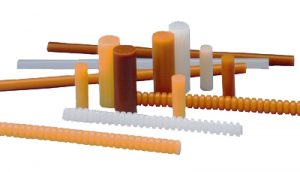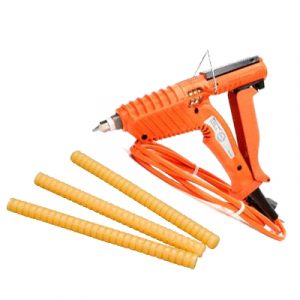A hot melt adhesive, also known as a hot glue, is the name given to a polymer-based glue which is solid at room temperature and is applied in a molten state.
There are three main stages to the process of a hot melt adhesive bonding together materials. Firstly, the solid adhesive is heated until it reaches its softening point, at which stage it will turn to liquid. The molten adhesive is then applied and wets the substrate. The period available to make the bond between applying the thermoplastic adhesive and bringing in the secondary material is called the open time. Lastly, cooling time will then occur. This typically varies from just a few seconds to up to 5 minutes, and during which the hot melt will solidify and very quickly build up strength and stability. This fast turn around allows for a quick processing time and rapid assembly.
Main Components of Hot Melt Adhesives:
Polymers: These help to give the adhesive strength and flexibility, as well as heat and impact resistance.
Resins: Control the wetting of the adhesive (how long it remains a liquid whilst in contact with the substrate).
Wax: Primarily controls the open time, and how long the bond takes to form. It also helps thin the adhesive for application. The higher the wax content present within a hot melt, the higher viscosity and greater flexibility the bond will have. High levels of wax also allow for a quicker bond.
Antioxidants: These are used primarily to help preserve the material during its shelf life.
Equipment required for hot melt adhesives:
 The equipment which accompanies the hot melt glue is just as important as the adhesive itself, since without the glue gun there is no way of heating the adhesive to the correct application temperature. The glue gun also allows for accurate and precise application onto the substrate. Each gun is specifically made to suit a different need, such as the 3M Hot Melt Low Temperature Applicator LT which maintains a temperature of 129ºC making it an ideal choice for heat sensitive surfaces such as foam and plastics. If a higher temperature is required, the 3M Hot Melt Touch Control Adhesive Applicator TC dispenses up to 196 ºC and is great for more detailed work.
The equipment which accompanies the hot melt glue is just as important as the adhesive itself, since without the glue gun there is no way of heating the adhesive to the correct application temperature. The glue gun also allows for accurate and precise application onto the substrate. Each gun is specifically made to suit a different need, such as the 3M Hot Melt Low Temperature Applicator LT which maintains a temperature of 129ºC making it an ideal choice for heat sensitive surfaces such as foam and plastics. If a higher temperature is required, the 3M Hot Melt Touch Control Adhesive Applicator TC dispenses up to 196 ºC and is great for more detailed work.
Advantages of Hot Melt Adhesives:
Good for hard to reach areas: As the adhesive is applied in a purely liquid form, it allows for easy application to more obscure places or surfaces which other glue or adhesive products cannot do as well. Many glue guns and nozzles are manufactured to distribute the glue into these small complex places ensuring the entire chosen surface is reachable and covered which in turn, allows for stronger bonds.
Speed and ease: As the whole process of using hot melt adhesives is quick, this lowers assembly time and allows for optimum productivity with a fast turnaround.
Bonds variety of substrates: Hot melt adhesives are specially formulated for specific tasks. A wide variety of materials can be bonded, such as wood or corrugated cardboard. Heat sensitive materials such as foam or even some plastics and metal can also be bonded using hot melt adhesive when dispensed at a lower temperature. They can also bond both porous and non-porous surfaces.
Neat Application: The bond which forms from a hot melt adhesive is practically invisible which gives an overall pleasing aesthetic. This is particularly useful when used for items such as signs, displays or even furniture.
Long shelf life: Hot melt adhesives have excellent moisture resistance and do not need refrigeration meaning they remain firmly bonded for an extensive period.
Challenges of hot melt adhesives:
As with most adhesive products, alongside the benefits, hot melt adhesives have a few limitations. The temperature at which hot melt adhesives are set at is crucial to the application process.
- Once molten, the adhesive must be hot enough for assembly. If the adhesive is not hot enough at this stage, a weak bond may be formed which is also known as a cold bond.
- However, if the hot melt adhesive is applied in a molten state at too high a temperature, it will remain in a liquid state for too long and result in a soft bond being formed. Any stress or weight on this bond will cause a weakening which could fail immediately.
- Unlike other adhesives, if hot melts bonds are re-heated to their softening point temperature, the previous adhesion caused by the cooling process can be reversed. Although this does make hot melt adhesives more flexible and easier to repeatedly change, it can cause a hindrance should this be applied to a substrate which will undergo or survive in an environment with higher temperatures. However, many hot melts are now being manufactured with higher levels of heat resistance to combat this.
Common Industries:
Packaging Industry |
Electronic Industry |

Automotive Industry |

Bookbinding Industry |
Furniture/Woodwork Industry |
Retail Industry |
 Shop our range of Hot Melt Adhesives here.
Shop our range of Hot Melt Adhesives here.
Additional links:
At Ellsworth Adhesives, we supply a wide range of hot melt adhesives and glue guns from leading brands Henkel Loctite and 3M. View our complete range of hot melt adhesives here.
Unsure if hot melt adhesives are right for you? Our Glue Doctor is available to answer any technical questions you may have. Simply fill out our enquiry form.




